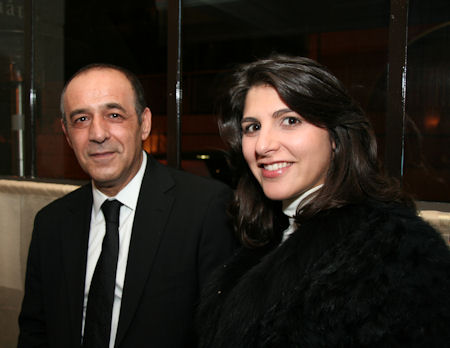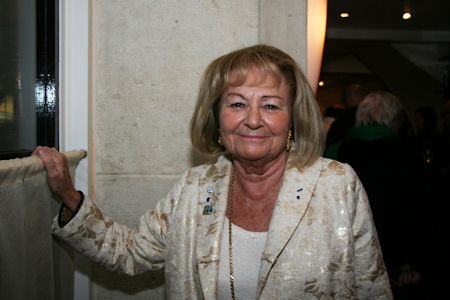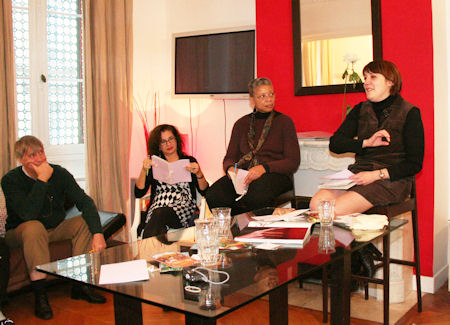A young woman pretending to be deaf and dumb tries to solicit money from a passerby. This is a common sight in Paris!
Like our blog? Join us on Facebook!

A young woman pretending to be deaf and dumb tries to solicit money from a passerby. This is a common sight in Paris!
Like our blog? Join us on Facebook!
I was happy when I recently received an invitation to attend a cocktail dînatoire at Mavrommatis, a Greek restaurant located at 42, rue Daubenton in the 5th arrondissement in Paris. This would be an opportunity to learn more about Greek food and to get reacquainted with the restaurant that I have reviewed on two occasions for our Paris Insights – The Restaurant Review page.
I last reviewed the restaurant on March 19, 2012, and at that time was quite pleased with the cuisine, ambiance, and service there. “Has the food changed? Has it gotten even better?” I wondered. I was soon to find out that it would exceed all expectations!
I was one of the first to arrive and had a chance to stroll freely around the two handsome dining rooms before other guests came. I admired the tables set with food and drink and read some of the table cards that announced the names of the dishes:
• Crevette obsiblue, pates avoine, jus de crustacé, condiment roquette, artichaut et mastiha (Obsiblue prawns with oat pasta, crustacean juice, rocket, artichoke and mastic condiment)
• Bar de ligne mariné aux algues et citron (Bass marinated in algae and lemon)
• Saint Jacques grillées marinées aux épices (Grilled scallops marinated in spices)
• Huitres au raifort, crème de choux fleur et mastiha (Oysters with horseradish, cream of cauliflower and mastic)
• Chocolat et mastiha (Chocolate and mastic)
• Crème de lait à la fleur d’oranger et masthia (Cream of rice with orange blossom and mastic)
• Riz au lait et mastiha (Rice pudding with mastic)
One can readily see from the names of these dishes that masthia (mastic) was a featured ingredient. Mastic is a resin from the mastic tree, traditionally produced on the Greek island of Chios. To my taste, it has a mild flavor of pine.
I started the evening with a cocktail made from Metaxa, a grape brandy fortified with Muscat grape, herbs, and rose petals. The cocktail was mixed with Enosis (a mastic liqueur), tonic water, and mint. It was a refreshing beverage with a nutty flavor.
Waiters began circulating, presenting platters of warm, savory appetizers, including keftèdes and crispy pittas.
I also enjoyed a goblet of red mullet and tarmasalata (fish paste) in a lobster mousse flavored with mastic, all topped with a layer of green-apple gelatin.
By the time dessert was served, I was quite sated, but couldn’t resist trying a dark chocolate ganache. It, too, was flavored with mastic.
I met two of the founders of Mavrommatis, several members of the staff, and several VIPs.

Marios Lyssiotis – Ambassador of Cyprus to France
Anna Papasawa – Consul
Photograph by www.DiscoverParis.net

Hélène Moussoulos
Chargée des Relations Publiques for the Cypriot Community of France
Photograph by www.DiscoverParis.net
Madame Moussoulos told me that in her opinion Mavrommatis serves the best Mediterranean cuisine in all of Europe. (That would include Cyprus and Greece!)
A good time was had by all!
We participate in Wanderfood Wednesdays. Head over there to explore food from around the world!
Like our blog? Join us on Facebook!
Last weekend we had the opportunity to stay in an apartment that was loaned to us by Habitat Parisien. It is located near the Bourse in the 2nd arrondissement, an area that doesn’t seem to be on too many travelers’ radar. This gave us the occasion to explore a neighborhood with which we had previously only been scarcely acquainted.
We arrived at the rue Vivienne apartment at 5:00 p.m. and checked in. At 7:30 p.m., we headed to a bistrot called Restaurant Clémentine that is located only one block away on rue Saint-Marc. (Read our review at the following link: Paris Insights – The Restaurant Review.) In its old-fashioned setting (the restaurant was founded in 1906) we had a fine, modern meal. The food wasn’t the heavy cuisine that is often associated with bistrots. If the evening we spent there had been the only thing we did that weekend, it would have been worth it!
After dinner, we wandered around the neighborhood and spotted a lively café called Le Bouillon on the corner of rue Saint-Marc and rue Vivienne. A lot of customers were sitting on the terrace drinking cocktails and I noticed that Irish coffee was on the happy-hour beverage menu. We decided to return there in the morning for breakfast. On our way back to the apartment we passed by Lefty, a burger restaurant that bills itself as an “American bistro.” The bartenders were cordial as they handed us a business card, but we didn’t return to try their fare.
In the morning, we returned to Le Bouillon for a fixed-price breakfast consisting of a demi-baguette split in half, butter, jam, a glass of orange juice, a hot beverage, and a bowl of scrambled “eggs” with “cheese.” The eggs were not moist and soft as we had anticipated, but were rather dry and grainy. They appeared to have been reconstituted from a powder because they did not have true egg flavor or texture. The cheese (which I could barely taste) in the eggs must have contained a lot of salt, because we were quite thirsty for the rest of the day. The orange juice tasted as if it had been made from concentrate and the hot chocolate that Monique ordered was thin and flavorless. My café crème was adequate, but I was surprised that I couldn’t find it listed as one of the beverage choices for the fixed-price breakfast. It was served as a courtesy, in place of the double espresso that was listed there. Why the management didn’t offer the choice of a café crème on this menu was beyond my comprehension.
Happily, our disappointing meal at Le Bouillon was easily forgotten the following day when we had breakfast at Le Pain de la Bourse, a restaurant only a block away. For details about the breakfast, read my review in Paris Insights – The Restaurant Review.
On Saturday, we strolled through the neighborhood and spotted a number of noteworthy sights.
First, there is the Bourse, the former stock exchange designed by Alexandre-Théodore Brongniart and constructed from 1808 to 1826. Two wings were added in 1902 and 1907. No longer the home of the stock exchange, the building is now called Palais Brongniart and is used as a conference and event center.
Nearby we came upon a columned street called, appropriately enough, “rue des Colonnes.” In close proximity stands a sign that indicates that the street is one of the rare examples of construction that took place during the Revolution.
The area is famous for its covered passages built in the 19th century. We came upon the Passage des Panoramas, and across boulevard Montmartre, spotted the entrance to Passage Jouffroy. Next door to this latter passage stands the famous wax museum, Musée Grevin, opened in 1882.
Walking west along rue du 4 Septembre, we came upon the opulent Opéra Garnier, built from 1861 to 1875.
Looking south into the 1st arrondissement we could see Place Vendôme with its majestic Vendôme Column, surmounted by a statue of Napoleon I.
From avenue de l’Opéra, we caught a bus back to our apartment in the 5th arrondissement, ending our weekend adventure in the historic 2nd.
If there is one thing that we learned from our stay in the apartment on rue Vivienne, it is that there is a lot to explore in the area around the Bourse!
Like our blog? Join us on Facebook!
Getting the chance to spend a weekend at an apartment loaned to us by Habitat Parisien was a great opportunity to accomplish two things: explore a Parisian neighborhood with which we were unfamiliar and invite some friends over for a small party. We’ll tell you about the neighborhood in our next blog post. Today, we’re sharing the details about our little social gathering — a dégustation that we organized with Marie-Hélène Gantois of Mococha Chocolat. We invited eight persons to the apartment for an event that was filled with laughter, conversation, and chocolate!
Marie arrived early to set up. She brought three varieties of single-origin, dark-chocolate bars (75% chocolate), booklets containing information to accompany the event, and a number of flavored ganaches (filled chocolates) to taste.

From left to right:
Eric Anthonissen – Adrian Leeds – Monique Y. Wells – Marie-Hélène Gantois
Photograph by www.DiscoverParis.net
After Marie gave an overview of chocolate production, she had us take a quiz that revealed our chocolate personality. It consisted of eleven multiple-choice questions, the answers to which showed that I am a choco-intuitive personality, one who is “hypersensitive to beautiful things.” Monique turned out to be a choco-festive type, a person who likes to share with a group.
Marie proceeded to have us taste the chocolate bars, one by one. Produced by Patrice Chapon, they were made from cocoa beans from Equador, Peru, and Cuba. I liked the one from Cuba the best—it had an earthy flavor and the longest finish.
Tasting chocolate doesn’t mean that you just pop a morsel into your mouth and gulp it down. Oh no! We followed a meticulous procedure that included clearing the palate (drinking a small amount of water), breaking the piece of chocolate (to listen to its “snap”), smelling the chocolate (to experience its aroma), allowing a piece to melt on the tongue (to taste it), and observing the lingering effects of the chocolate in the mouth (to identify its aftertaste).
After following this tasting procedure, which required great restraint on the part of all of the participants, Marie proceeded to conduct a blind test of filled chocolates. She offered a chocolate ganache to each of us and invited us to identify the flavors in each one. The first person to identify them would win a prize! Basil was the first flavor to be correctly identified, followed by ginger, coco-cinnamon, and tonka bean, No one identified the wasabi in the second ganache, but we all enjoyed trying!
Finally, Marie offered us a bonus chocolate — a paper-thin disc reminiscent of a large communion wafer that was flavored with cumin and paprika. One of our invitees correctly identified the paprika but no one could identify the cumin.
In the end, everybody won a prize—a box of four ganaches to take home. These chocolates were made by the three master chocolate makers that Marie features in her shop: Fabrice Gillotte, Jacques Bellanger, and Patrice Chapon.
The tasting event lasted about three hours, but we barely noticed — time passes quickly when you are having fun!
From left to right, top to bottom:
Adrian Leeds
Danielle Alvarez
Patricia Rosas
Sandy Allen
Diane Anthonissen
Eric Anthonissen
John
Monique Y. Wells
Richard Allen
We participate in Wanderfood Wednesdays. Head over there to explore food from around the world!
Like our blog? Join us on Facebook!
We were recently contacted by Habitat Parisien, an agency that rents apartments for short-term stays in Paris. Would we, they asked, be interested in staying in one of their apartments for a weekend in November in exchange for a blog about the experience?
Seizing an opportunity to explore a Parisian neighborhood that we knew little about, we replied affirmatively. We selected a large (68m2) apartment on rue Vivienne in the 2nd arrondissement, an area in which we rarely venture.
One of the charming aspects about the apartment that we selected is that rue Vivienne, lined with shops that trade in bullion and gold coins, doesn’t look like a street on which anybody lives. The façades look old, and we learned later that the street and a number of buildings on it date from the 17th century. An acquaintance, whom we happened to bump into on our last day and who lives in the neighborhood, affirmed that he likes the area precisely because it looks uninhabited. “You push through old doors, climb creaky stairs, and find yourself in a beautiful apartment.”
Mathias, who works for Habitat Parisien, greeted us at 5:00 o’clock on Friday evening in front of the building and ushered us two flights up a well-worn, wooden stairway to the second-floor landing. There, two heavy, imposing doors stood directly in front of us. Mathias unlocked one of them, we pushed through, and voilà!…we stepped into a large, handsome apartment.
Mathias presented Monique with the key to the apartment and followed by giving her two long-stemmed roses. A lovely gesture! He walked us through the apartment, pointing out its features, and took care to explain how the different appliances worked. He helped us connect our computer to the apartment’s WiFi and tested the phone before leaving us to enjoy our evening.
“Vivienne,” as the apartment is called, is equipped with a dishwasher, clothes washer, Jacuzzi tub, and wide-screen television. There is also a large enclosed balcony that provides a lovely view of rue Vivienne and its intersection with boulevard Montmartre. We didn’t use it much, but that first evening we learned that it serves as an effective buffer against traffic noise. The apartment was quiet and we slept well.
The bare, hardwood, herring-bone floor made wonderful creaking noises as we stepped on it — it was a pleasure to walk across in bare feet. Because of the high ceilings, we were concerned that we might not be warm enough, particularly because the weather was cold and damp on that first day. We were pleased to learn that two electric heaters on the wall adjacent to the balcony worked extremely well — we were quite warm and didn’t need to turn on the third heater located near the kitchen.
The Jacuzzi gave a great massage and we appreciated the towel warmer in the bathroom. The open kitchen was adequate, with a dishwasher, coffee maker, microwave, and toaster. Although we chose to eat out rather than prepare our own meals, we noted that there were plenty of plates and glassware.
Tomorrow…the party that we threw for our friends.
Like our blog? Join us on Facebook!
We found this month’s featured fanny on a pediment high above boulevard des Italiens in the 2nd arrondissement. The allegorical figure to whom these fesses belong is part of a group sculpted by Camille Lefèvre in 1880-1883.
Follow the link below for a close-up view!
pinterest.com/pin/411586853416461175/
Like our blog? Join us on Facebook!